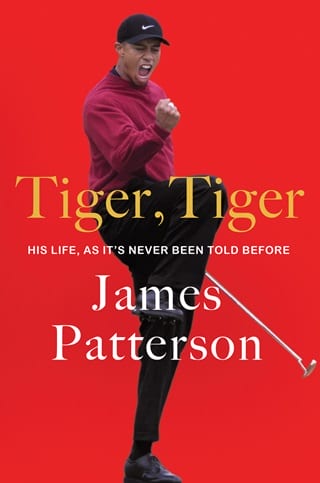Chapter 23
Nike world headquarters
Beaverton, Oregon
September 1996
The “Hello world” tagline launches as an exclusive three-page advertising spread in the Wall Street Journal the day after Tiger’s initial press announcement.
When Tiger used those same words to greet reporters assembled in the Brown Deer Park hospitality room, Larry Dorman of the New York Times found the phrasing “almost sweet, a sort of spontaneous, unaffected way to begin,” a last vestige of Tiger’s amateur status.
It’s quickly evident that “Hello world” was a ready-and-waiting Nike campaign.
“So much for the naivete,” Dorman writes. “This is pro ball now, the real world, and welcome to it.”
TV spots featuring Tiger start rolling out almost immediately on the CBS telecast of the Greater Milwaukee Open as well as on ABC’s Monday Night Football, Fox, and ESPN. The ads have been preproduced by Nike’s Portland-based ad agency, Wieden+Kennedy, known for its edgy, attention-grabbing style. “Nike has always tended to go out on a limb to take advantage of the moment,” says Rod Tallman, director of marketing for Nike Golf.
The ads are scripted in the first person and voiced by an actor who delivers a list of Tiger’s astonishing accomplishments, building to the reveal: “There are still courses in the U.S. I am not allowed to play because of the color of my skin.”
Creative director Jim Riswold fields so many calls from reporters about the spots that changing his phone number starts to seem like a good idea.
On September 17, James K. Glassman of the Washington Post opens his column with “You don’t have to like golf to love Tiger Woods.” However, he states, Nike’s “dishonest ad campaign” is a problem.
“I called Nike to get a list of the courses he’s not allowed to play,” Glassman writes. “Finally, James Small, the company’s public relations director in Beaverton, Oregon, called me back.”
Small tells Glassman that he’s “absolutely right”: “Tiger Woods can play on any course he wants” but that “the goal of the ad was to raise awareness that golf is not an inclusive sport.”
According to a Nike spokesman, “the impetus for this text came as much from Woods as from Nike.” Another Nike staffer observes, “Tiger approved it, but he had a thousand things going on that week.”
Of the “Hello world” ad, Tiger says, “That was the truth and that was based on my own experiences.”
But his life, as represented by those few lines of ad copy, has already changed. He is now the chairman of a newly formed Tiger Woods, Inc., corporation. Earl is president. “In a way,” Tiger tells Sports Illustrated, “I’ve gone from being a college sophomore to a mini-CEO.”
The newly crowned “Fresh Prince of golf” is tired. The young man known to the world by one name—Tiger—is dog tired.
“I know one thing,” Tiger, the “champion sleeper,” says, his eyes drooping. “When I get my Tour card, I’ll never play five weeks in a row again.”
Since winning the U.S. Amateur and professionally debuting at the Milwaukee Open, Tiger’s crisscrossed the continent in a chartered jet, finishing eleventh at the RBC Canadian Open, outside Toronto, during the remnants of Hurricane Fran and topping the leaderboard at the Quad Cities Open, in Coal Valley, Illinois, until he ran into trouble with a quadruple-bogey 8 in the final round and slipped to tie for fifth.
A disappointment for sure, but still amazing to come so close to winning a mere three tournaments into his professional career. He’s upset, but he’s able to shrug off the loss at dinner that night with his best friend, Bryon Bell, and his dad as well as his IMG agent, Hughes Norton, and his swing coach, Butch Harmon. “Let’s face it, I fell on my ass,” he says, but “by dessert we were laughing about how bad I blew it.”
Tiger reframes the loss as “part of a learning process,” saying, “In golf, you lose more than you win.”
Now it’s on to upstate New York for his fourth PGA Tour event in three weeks—the B.C. Open, in Binghamton, where he checks in to a tenth-floor suite at the Binghamton Regency.
“This is my house,” Tiger jokes. “Do you like my house? It’s got a lot of rooms. It’s got maids. It’s got elevators. The only problem is I have to move into another one like it every week.”
Practice rounds are canceled because of ongoing rain. “The weather has been a blessing,” Tiger admits, since it gives him a chance to finally catch up on sleep—and look through the boxes of clothes Nike has sent over. The color-blocked shirts he likes might become part of the Swoosh 18 line that Nike’s designing for him.
The B.C. Open tournament at En-Joie Golf Club precedes the first week of the fall quarter at Stanford, where classes start on September 25. Tiger may not be heading back this semester, but to the Haskins Commission, he’s still a Cardinal. Since 1971, the Haskins Award—known as the Heisman of golf—has been awarded annually to outstanding male collegiate golfers, and Tiger’s made a clean sweep of the vote for 1996. He adds the Haskins Award ceremony to his calendar and confirms the event with the commission.
The rain lets up enough on Wednesday for Tiger to play in the pro-am and sign endless autographs. No need to order hotel room service when there’s a McDonald’s nearby. He eats takeout—a Quarter Pounder with Cheese, fries, and a strawberry shake—and watches the Atlanta Braves play the Houston Astros. By nine thirty, he’s in bed for the night. Tee time tomorrow is 9:00 a.m.
“No,” he says when golf reporter Jaime Diaz asks about his nerves. “Why should I be nervous? That’s for game time. I’m going to sleep like a log.”
In Thursday’s opening round, Tiger’s paired with tour pro John Maginnes. On the par-five 3rd, they’re looking at their second shots. Maginnes has about 240 yards to the green. He’s thinking he might barely get there with a 3-wood. Tiger drove his tee shot into the woods; it kicked out, but he’s thirty yards back of Maginnes, 270 to the green. Tiger chooses an iron for his second shot, and Maginnes, thinking Tiger is going to lay up, is stunned by the result. “I’m standing ten feet away from the hardest golf swing I’ve ever seen in my life, the loudest contact to a balata golf ball I’ve ever heard,” he says. “And this ball took off and looked like a laser.”
Maginnes turns to Tiger’s caddie, Mike “Fluff” Cowan. “Fluff, what the F was that?”
“That’s our 2-iron we carried about 275,” Cowan says.
Fans—young and old, Black and white—line the course, hoping for autographs.
The novelty of it is still exciting to Tiger. “That’s been the best part,” he says. “The crowds have been super. Most of them are kids. Me being one year from being a teenager, maybe they feel they can relate to me. I think that’s great.”
In Milwaukee, teenage fans had screamed for Tiger so persistently that he’d had to go to a window and wave to quiet them down. “It was like he was the pope!” Tida says with a laugh.
Some female fans are especially interested in the twenty-year-old.
“Tiger, I love you!” one teenage girl shouts.
That gets Tiger’s attention.
“Oh, my god, he looked at you!” the girl’s friend gasps.
Not everyone is lucky enough to get into En-Joie Golf Club. Those outside the gates hold up signs that say I NEED TICKETS.
Tournament play is cut short at fifty-four holes by a hard and soaking rain. Fred Funk, winner of two events on the 1995 PGA Tour, takes the B.C. Open title in a one-hole playoff. Tiger ties for third and earns $58,000. His largest prize yet advances him to a total of $140,194 and number 128 on the money list. The top 125—plus exempt status and his full-time PGA Tour card—is just three spots away. Winning one of the few remaining PGA events this year will also get him there.
Watching tournament replays on the Golf Channel, Tiger likes what he sees. “Hey, my shoulders are bigger,” he points out. “I’m not such a skinny little kid anymore.”
Out on the road, he hits local gyms to keep up his weight workouts, doing incline presses with sixty-five-pound barbells, squatting 250 pounds, and ending every session with five hundred crunches to strengthen the lower back muscles that power his swing. The routines have packed on some muscle weight—he’s up to 158 pounds now.
“I’m stronger than I look,” he jokes, but the relentless perfectionist is prone to self-criticism. “Tiger! You’re terrible,” he says to his image on-screen, then checks in with Harmon for advice on club and wrist position.
There’s always room for improvement, but it won’t mean anything, he says, “if I don’t keep my focus. I just have to keep going.”
 Fullepub
Fullepub 



